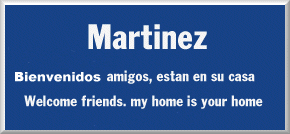
The name MARTIN is very old, dating back to
the 3rd century (316). The name was made very popular by St Martin of Tours.
St Martin was born at Sabaria, Pannonia (in an area that is now known
as Hungary), the son of pagan army officer, he was taken to Pavia when his
parents moved there, and then when he was fifteen he was inducted into the
army against his will. About the 337 A.D. occurred the famous incident at
Amiens where he was stationed. He cut his cloak in half and gave half
of it to a poorly clad beggar in the freezing cold. During the night he had
a vision of Christ clad in his half cloak. He became a convert to Christianity.
While in the army he refused to fight, and was discharged soon after.
He returned to Pannonia, converted his mother and others. He was very
active in the spread of Christianity and vigorously opposed paganism. Many
times he was in great danger and was always saved from harm by seemingly
miraculous occurrences. Martin made a visit to Rome and then went to Candes
in Touraine, where he established a religious center. He died on November
8. Martin was one of the great saints of Gual and outstanding pioneer of
Western Monasticism before St Benedict. St Martin's shrine at Tours became
on of the most popular pilgrim center in Europe, and he is one of the patron
saints of France. Celebrated on November 11th.
St Martin is the parton Saint of Beggars,
tavern keepers, and publicans.
His festival in the Roman
and Anglican churches is November 11th. Martinamas is the name given to the
day in England" It is the time when cattle are killed for the winter use,
and the new wine is drawn from the lees and tasted. The celebration
was very common over most of Christendom, and it has been a somewhat jovial
occasion which everyone looks forward to
celebrating.
Five Popes have had the name Martin. Martin
the 1st was a bishop at Todi, on the Tiber River, Italy in the Crimea, Sept
16, 665. He was canonized and made a Saint. Then there was Martin the 2nd
who was incorrectly ascribed to a Pope Marinus 1st. Pope Martin 3rd was
incorrectly ascribed to as Marinus 2nd. The last two were Martin the 4th
and Martin the 5th.
If you are wondering why I am discussing the name
Martin instead of Martinez it's because in Spanish the
ez, es, is, and iz all mean the son of
......... In the case of Martinez, it's MARTIN + EZ, which means the father
was Martin and the son or sons were Martinez.
Other examples of Spanish names with the ending
are: Rodrigo + ez = Rodriguez, Ramiro + ez = Ramirez, Muno + iz = Muniz,
Nuno + ez = Nunez, Alan + Iz = Alaniz, Lope + ez = Lopez, Fernando + ez =
Fernandez, Hernando + ez = Hernandez, ect.
The name MARTIN is found all over Europe, in Spanish,
English, Scots, Irish, French, German, Czech, Flemish/Dutch, Norwegian,
Portuguese, Hungarian, Poland, Italy, ect..
For Example: Italy: Martini, Martino, Martina
(fem), Prov: Marti, Marty. Spain: Martin, Cat: Marti. Portuguese: Martinho.
Low German: Mar(h)en; Merten. Sweden: Morton, Hungarian: Marton. England:
the name varies to the spelling of Marten, Martyn. In France: Martine, Lamartine
(fem form).
Dims. France: Martineau, Martinet, Martinon, Martino;
Tinot (an aphetic form).German: Martl, Mertel, Mortel (Bavaria); Switzerland:
Marti, Marty. Italy: Martello, Martinelli, Martinetto, Martinol (latin)
Martinotti, Martinuzzi. Flemish Dutch: Meer. Lovw German: Mertgen, Tienke.
German (of slavic orgin) Martsch (ke), Martischik, Mertscing, Ukrainian:
Martinyul, Martinets. Czechoslovakia: Martinek, Marek. Poland: Martynka,
Marciek.
The Martinez name is found
all over the Spanish peninsula. I chose this coat of arms because
it is from Galicia, Spain. I could also have selected the coat of arms from
Asturias, because these are the two areas where I found my Martinez roots,
however this does not mean that it is my coat of arms. It only means that
this the coat of arms belonging to the Martinez family in
Galicia. In fact, Asturias has two coat of
arms listed which I could have selected. Many people think that
because a coat of arms bears their last name that they entitled to use
it. This is not the case, unless you are able to
connect to the family that owns it. However,
it is possible to
make the connection to these titled families.
One never knows, it could
be the crowning achievement of ones
research.
As I researched the name Martinez and coat of arms
I found that Alberto Garcia Carraffa's books list about 31 Martinez coat
of arms. Carraffa is the authority on Spanish Heraldry. This list did not
include the Martin coat of arms or the female side of these marriages. Since
nobility married nobility, the female may have had her own family coat of
arms when she married a Martinez.
The Spanish nobility, unlike their European
counterparts, was based almost entirely on military service. Very few
eminent families came from medicine, law, commerce or the church. The
great families of Spain fought their way to their rank. But the descendants
of Spanish arms and titles differ from their European counterparts,
in that they can be inherited through females. Also, illegitimacy is no bar
to descendants of arms and titles. The great Spanish families believed
that a family pedigree could be more damaged by misalliance then by
illegitmacy.
 |
Back To Home Page |
 |
Family History Page |
 |
The Story of the Corn Chip |
|